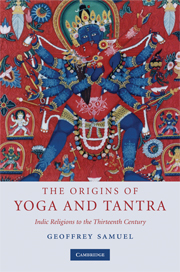Book contents
- Frontmatter
- Contents
- List of figures
- Preface
- 1 Introduction
- 2 Stories and sources
- PART ONE MEDITATION AND YOGA
- PART TWO TANTRA
- 9 The classical synthesis
- 10 Tantra and the wild goddesses
- 11 Subtle bodies, longevity and internal alchemy
- 12 Tantra and the state
- 13 The later history of yoga and Tantra
- 14 Postlude
- References
- Index
13 - The later history of yoga and Tantra
Published online by Cambridge University Press: 05 June 2012
- Frontmatter
- Contents
- List of figures
- Preface
- 1 Introduction
- 2 Stories and sources
- PART ONE MEDITATION AND YOGA
- PART TWO TANTRA
- 9 The classical synthesis
- 10 Tantra and the wild goddesses
- 11 Subtle bodies, longevity and internal alchemy
- 12 Tantra and the state
- 13 The later history of yoga and Tantra
- 14 Postlude
- References
- Index
Summary
Chapter 12 emphasised the ways in which the transgressive Tantra of the fierce goddesses, criminal gods and destructive magic, in both Brahmanical and Buddhist variants, was a part of state policy, adopted and supported by Indic and Indic-influenced states both in South Asia and overseas. In the Brahmanical states, as Gupta and Gombrich have noted, royal power and Tantric theology became closely intertwined, so much so that, as they note ‘one cannot be adequately understood without the other’ (Gupta and Gombrich 1986). The Buddhists provided similar services to the East Asian states, while in Southeast Asia we find elements from both Buddhist and Brahmanical sides.
It seems scarcely deniable that these pragmatic uses of Tantra provided a major context for the growth and development of Tantric religion. We can see early signs of this accommodation of state needs in Buddhist texts by the start of the fifth century, with the proto-Tantric maṇḍala and the state-supporting rituals of the Suvarṇaprabhāsa Sūtra and the Renwang Jing. We can see the development fully under way by the eighth and ninth century, with Buddhist Tantric rituals for state purposes being translated into Chinese and transmitted on to Japan, court patronage of Śaiva Tantra in Kashmir, and Śaivite rituals being used for state consecrations and state-protective rituals by the Khmer kings. Doubtless there was plenty of smaller-scale employment of Tantric religion, at any rate by those wealthy enough to employ Tantric ritualists.
- Type
- Chapter
- Information
- The Origins of Yoga and TantraIndic Religions to the Thirteenth Century, pp. 324 - 338Publisher: Cambridge University PressPrint publication year: 2008



